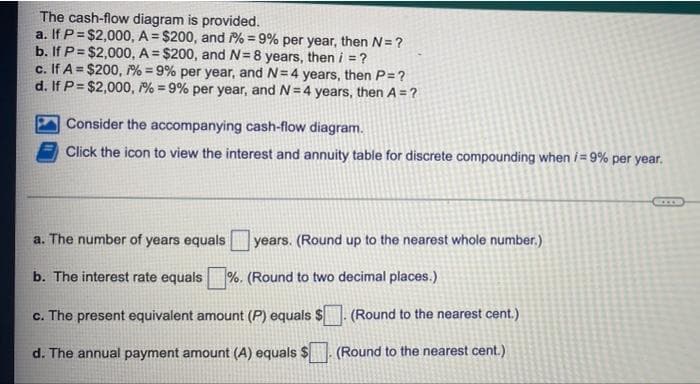The cash-flow diagram is provided. a. If P = $2,000, A = $200, and 7% = 9% per year, then N= ? b. If P= $2,000, A= $200, and N=8 years, then / = ? c. If A = $200, 1% = 9% per year, and N=4 years, then P= ? d. If P= $2,000, 1% = 9% per year, and N=4 years, then A = ? Consider the accompanying cash-flow diagram. Click the icon to view the interest and annuity table for discrete compounding when /= 9% per year. a. The number of years equals years. (Round up to the nearest whole number.) b. The interest rate equals%. (Round to two decimal places.) c. The present equivalent amount (P) equals $. (Round to the nearest cent.) d. The annual payment amount (A) equals $ (Round to the nearest cent.)
The cash-flow diagram is provided. a. If P = $2,000, A = $200, and 7% = 9% per year, then N= ? b. If P= $2,000, A= $200, and N=8 years, then / = ? c. If A = $200, 1% = 9% per year, and N=4 years, then P= ? d. If P= $2,000, 1% = 9% per year, and N=4 years, then A = ? Consider the accompanying cash-flow diagram. Click the icon to view the interest and annuity table for discrete compounding when /= 9% per year. a. The number of years equals years. (Round up to the nearest whole number.) b. The interest rate equals%. (Round to two decimal places.) c. The present equivalent amount (P) equals $. (Round to the nearest cent.) d. The annual payment amount (A) equals $ (Round to the nearest cent.)
Advanced Engineering Mathematics
10th Edition
ISBN:9780470458365
Author:Erwin Kreyszig
Publisher:Erwin Kreyszig
Chapter2: Second-order Linear Odes
Section: Chapter Questions
Problem 1RQ
Related questions
Question

Transcribed Image Text:The cash-flow diagram is provided.
a. If P = $2,000, A = $200, and 7% = 9% per year, then N= ?
b. If P= $2,000, A= $200, and N=8 years, then i = ?
c. If A = $200, 1% = 9% per year, and N=4 years, then P= ?
d. If P= $2,000, 1% = 9% per year, and N=4 years, then A = ?
Consider the accompanying cash-flow diagram.
Click the icon to view the interest and annuity table for discrete compounding when /= 9% per year.
a. The number of years equals years. (Round up to the nearest whole number.)
b. The interest rate equals%. (Round to two decimal places.)
c.
The present equivalent amount (P) equals $. (Round to the nearest cent.)
d. The annual payment amount (A) equals $ (Round to the nearest cent.)
Expert Solution
This question has been solved!
Explore an expertly crafted, step-by-step solution for a thorough understanding of key concepts.
Step by step
Solved in 2 steps with 2 images

Recommended textbooks for you

Advanced Engineering Mathematics
Advanced Math
ISBN:
9780470458365
Author:
Erwin Kreyszig
Publisher:
Wiley, John & Sons, Incorporated

Numerical Methods for Engineers
Advanced Math
ISBN:
9780073397924
Author:
Steven C. Chapra Dr., Raymond P. Canale
Publisher:
McGraw-Hill Education

Introductory Mathematics for Engineering Applicat…
Advanced Math
ISBN:
9781118141809
Author:
Nathan Klingbeil
Publisher:
WILEY

Advanced Engineering Mathematics
Advanced Math
ISBN:
9780470458365
Author:
Erwin Kreyszig
Publisher:
Wiley, John & Sons, Incorporated

Numerical Methods for Engineers
Advanced Math
ISBN:
9780073397924
Author:
Steven C. Chapra Dr., Raymond P. Canale
Publisher:
McGraw-Hill Education

Introductory Mathematics for Engineering Applicat…
Advanced Math
ISBN:
9781118141809
Author:
Nathan Klingbeil
Publisher:
WILEY

Mathematics For Machine Technology
Advanced Math
ISBN:
9781337798310
Author:
Peterson, John.
Publisher:
Cengage Learning,

